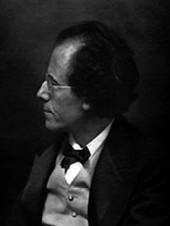

Gustav Mahler
7 frühe Lieder
Short instrumentation: 1 1 2 1 - 2 1 1 0 - perc(2), hp, pno, str (min: 3-2-2-2-1(5-Saiter); max: 12-10-8-6-4(5-strings))
Duration: 25'
Bearbeitet von: Eberhard Kloke
Dedication: Anna Prohaska gewidmet
Instrumentation details:
flute (+picc
alto fl)
oboe (+c.a)
1st clarinet in Bb (+2ndcl(A)
basset hn in Es)
2nd clarinet in Bb (+2ndcl(A)
bass cl(Bb)
cb.cl(Bb)
cl(Eb)
basset hn in Es)
bassoon (+cbsn)
1st horn in F (+wagner tuba in B)
2nd horn in F
trumpet in Bb (+Posthorn in B
cornet)
trombone (+cb.tbn)
harp
piano (+cel)
1st percussion
2nd percussion
violin I
violin II
viola
violoncello
double bass
Mahler - 7 frühe Lieder for soprano and orchestra
Printed/Digital
Translation, reprints and more

Gustav Mahler
Mahler: Sieben frühe LiederOrchestration: für Sopran und Orchester
Type: Dirigierpartitur

Gustav Mahler
Mahler: Sieben frühe LiederOrchestration: für Sopran und Orchester
Type: Studienpartitur (Sonderanfertigung)
Sample pages
Work introduction
Mahler’s early songs are influenced by the Wunderhorn theme to which he returned in his first symphonies (I–IV). Mahler borrows, as it were, from his other works in his early symphonic oeuvre, with further processing of musical material in a symphonic setting.
It should be emphasised that Mahler’s musical language and compositional substance became apparent in many different characteristics at a very early stage – already in the late 1880s and early 1890s. I consider most of the early songs, therefore, to be paradigmatic of his entire compositional oeuvre. As Mahler wrote many song orchestrations himself, adding instrumentation was a major challenge and could only be tackled in a procedure of compositional recreation.
For this transcription I attempted in a kind of reverse process to incorporate musical themes, compositional techniques, instrumentation quotations and allusions from the symphonic Wunderhorn world into the song orchestration and thus ‘interpret’ them in further composition.
Elements of the Wunderhorn theme from Symphonies I–IV were marked in this score as “Episode I, II, III, IV (for the symphonies); 1, 2, 3 ... (for the movements)”. The term “lontano” or “da lontano” frequently used by Mahler himself may serve as a metaphor for the technique employed in order to create a connection between subsequent/later musical developments and the early works. The title Seven Early Songs alludes to Berg’s song collection of the same name, which was composed at the same time as Mahler’s Wunderhorn material in his symphonies.
Eberhard Kloke
